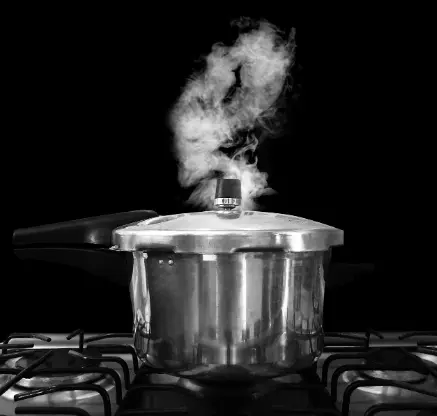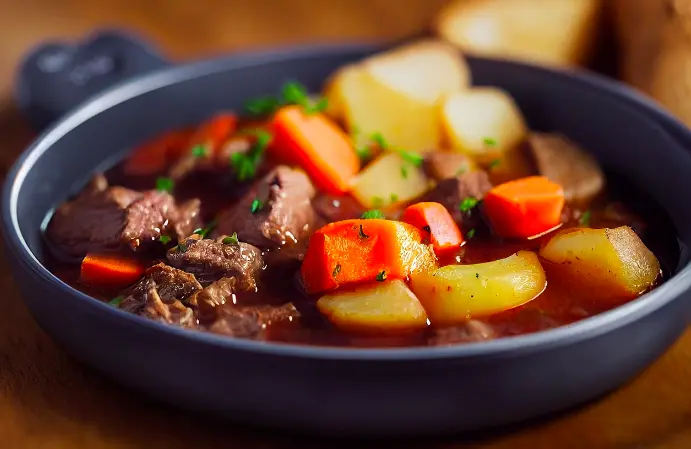Pressure Pointers: Mastering Safety in Speedy Cooking and How to Avoid Pressure Cooker Accidents
Luckily, I have never been burned by my pressure-cooker, but that doesn’t mean I haven’t had a close call with the steam! My aim with this post is to help you know how to avoid pressure cooker accidents in the kitchen because the risk is there! As with all kitchen appliances, it’s good to know how they work and what could happen so you can avoid accidents.
But, we’ll also share the pressure cooker’s good side, too! Because, after all, they’re helpful kitchen gadgets that every home cook should have! Plus, I’ll share a delicious and easy stew recipe that can be made with your trusty pressure cooker!
Steamy Situations: Preventing Burns

How Burns Happen: Burns from pressure cookers can occur due to hot steam or hot food splashing when the lid is opened hastily. This often happens if the pressure release valve isn’t used correctly. In pressure cooking, the contents inside reach high temperatures, creating steam under high pressure. Opening the lid without properly releasing this steam can result in severe burns.
Safety Protocols: To prevent burns, it’s crucial to use the pressure release mechanisms correctly. Modern pressure cookers come with either a quick release or natural release function. The quick release allows for the release of steam pressure rapidly, while the natural release takes longer but is generally safer, as it lets the steam dissipate slowly. Always stand back when opening the lid and never put your face or hands over the steam release valve.
Preventative Measures: Wearing oven mitts and using utensils with long handles are good ideas to prevent contact with hot surfaces. Ensure that the steam release valve isn’t clogged with food particles, as this can lead to unexpected bursts of hot steam. Remember, preventing pressure cooker accidents starts with respecting the high temperatures and steam pressure involved in the cooking process. Following these precautions will make you a pro on how to avoid pressure cooker accidents.
Under Pressure: Sidestepping Explosions
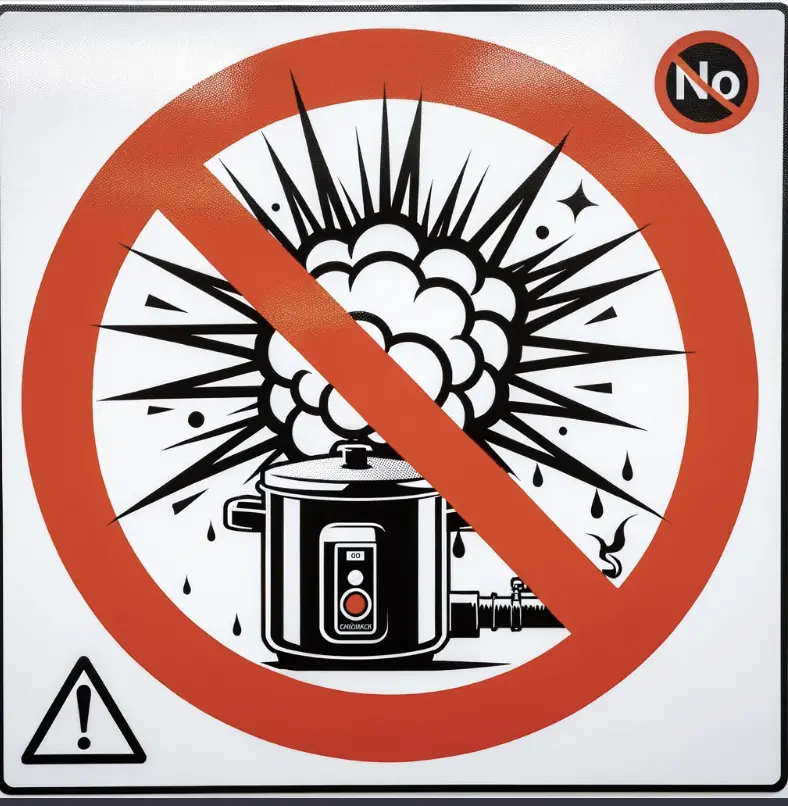
Causes of Explosions: Pressure cooker explosions, though very rare in today’s pressure cookers with advanced safety features, can occur due to overfilling, blocked vents, or faulty gaskets. When too much pressure builds up without an escape route, the risk of explosion increases. Overfilling the cooker beyond the maximum fill line can cause food residue to block the steam valves, leading to excess pressure.
Preventing Kabooms: To avoid pressure cooker explosions, always follow the manufacturer’s instructions. Never overfill the cooker – respect the max fill line. Regularly inspect the rubber gasket and sealing ring for wear and tear. If you notice any damage, replace these parts before using the cooker again. Also, make sure the pressure release vent and valves are clean and not obstructed by food particles.
Emergency Handling: If your pressure cooker starts hissing unusually or shaking excessively, turn off the heat source immediately! Allow the cooker to cool down naturally. Never try to force it open. In case of a suspected faulty pressure cooker, contact the manufacturer or consider seeking advice from a law firm experienced in pressure cooker explosion lawsuits, especially if there’s a risk of severe injuries or personal property damage.
Avoiding Impact Injuries: Lid and Beyond
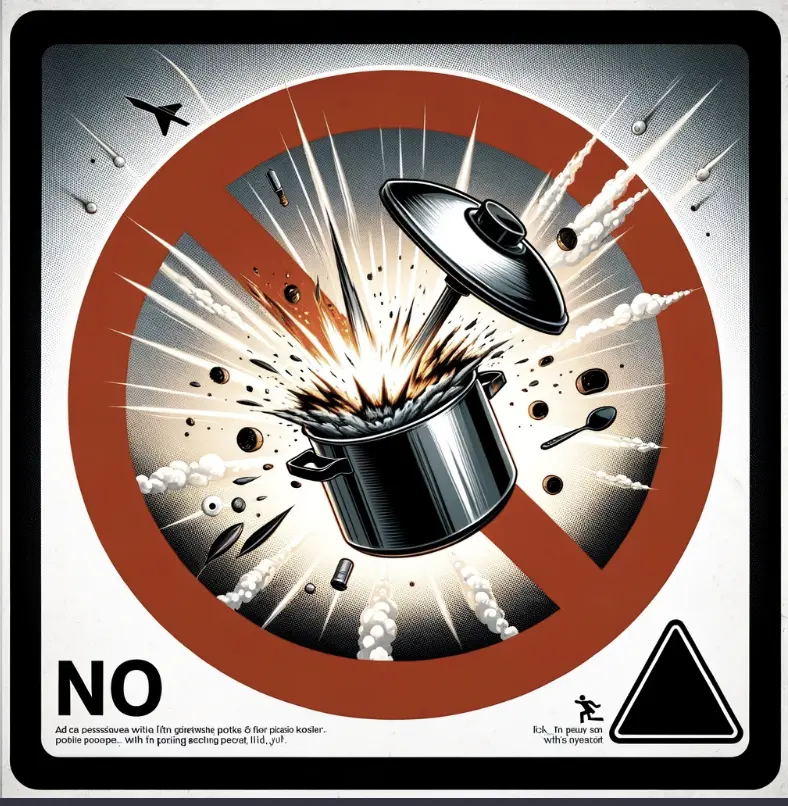
How Impact Injuries Occur: Impact injuries can happen if the lid of the cooker suddenly shoots off due to high pressure inside. This is more common in older models without modern safety features. The lid can become a dangerous projectile, potentially causing serious injuries.
Lid Safety: Always ensure that the lid of your pressure cooker is securely locked before starting the cooking process. Modern pressure cookers have safety mechanisms that prevent the lid from being opened while under pressure. It’s a good idea to regularly check these mechanisms and consult your pressure cooker manual to ensure everything is in good shape.
Environment Setup: Keep the area around your pressure cooker clear of clutter. Ensure it’s placed on a stable, heat-resistant surface, away from the edge of the counter. Teach family members, especially children, to stay clear of the pressure cooker during use. Awareness and a well-organized kitchen space can significantly reduce the risk of impact injuries from pressure cookers.
Sharp Matters: Cutting Down on Cuts
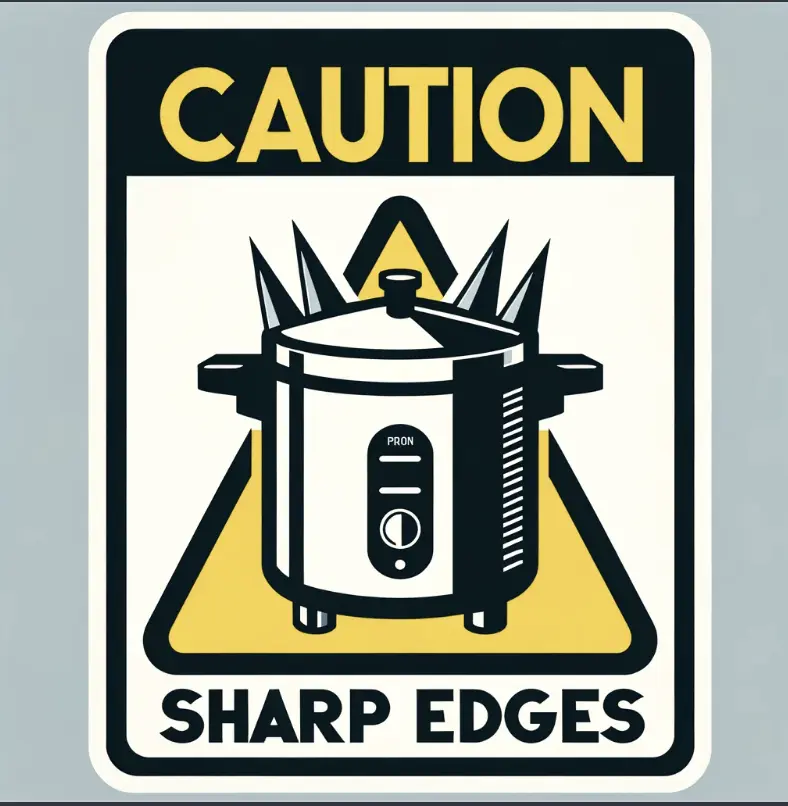
Risks of Cuts: Some pressure cookers, especially older models or those with a flawed design, can have sharp edges around the lid or the inner pot. Handling these parts carelessly can lead to cuts. Another common mistake leading to injuries is mishandling the cooker when washing or storing it.
Safe Handling: To avoid cuts, handle your pressure cooker and its components with care. When washing, pay attention to the edges of the lid and inner pot. Store the cooker and its parts in a place where they won’t have to be moved around too much, reducing the risk of accidental cuts. Always use the handles provided when moving the cooker.
Choosing Right: Selecting a pressure cooker with a user-friendly design can also help prevent cuts. Look for models with smooth edges and a sturdy, easy-to-grip handle. When purchasing a pressure cooker, consider the design just as much as the cooking capabilities. A well-designed pressure cooker is not just about the cooking times or pressure settings, but also about safe and comfortable handling.
Electrical Hazard Basics: How Electric Shocks Can Occur

Electric pressure cookers are a great tool in the kitchen, combining convenience with efficiency. However, like all electrical appliances, they come with their own set of risks, especially if not used correctly.
Electric shocks, though rare, can occur when there’s a fault in the cooker’s electrical system or when it’s used in unsafe conditions.
Factors such as a damaged cord, a malfunctioning heating element, or exposure to water can lead to these shocks. Understanding these risks is crucial in learning how to avoid pressure cooker accidents.
Preventive Steps: Proper Usage, Handling Electrical Components, and Moisture Control
The best way to prevent electrical shocks while using an electric pressure cooker is by following the manufacturer’s instructions.
Always inspect the cooker before use, checking for any signs of wear or damage, particularly on the cord and plug.
Keep the cooker away from water and never operate it with wet hands.
It’s a good idea to ensure that the cooker is placed on a dry, stable surface away from any heat source.
Be cautious with the inner pot, especially when it’s hot, and ensure the anti-block shield and steam release valve are clean and unobstructed. These are the keys on how to avoid pressure cooker accidents.
Maintenance Matters: Regular Checks and Care for Electrical Parts
Regular maintenance is key in preventing electrical hazards. Check and clean the cooker, including its lid, sealing ring, and pressure release valve, to avoid the buildup of food particles that could interfere with its functioning.
If your cooker has a removable rubber gasket or a float valve, inspect them for any signs of wear and tear.
Replace faulty gaskets or parts immediately, as they play a crucial role in maintaining the pressure cooker’s safety and efficiency. Remember, a well-maintained electric pressure cooker is less likely to cause accidents, making the cooking process safer and more enjoyable.
let’s switch gears!
Now that we’ve covered the essentials of safety with pressure cookers, let’s switch gears and dive into the more delightful aspect of these incredible kitchen allies. It’s time to move from caution to cuisine! Yes, knowing how to avoid pressure cooker accidents is crucial, but it’s equally important to explore how much can they do to help us in the kitchen.
Pressure Cooker Perks: Weighing the Benefits
Time Efficiency: The Significant Time-Saving Benefits
Why are pressure cookers so popular? It’s largely because of their ability to drastically reduce cooking times. What traditionally might take hours in slow cookers or on stovetops can be achieved in a fraction of the time with pressure cooking.
This efficiency is a result of the high pressure and high temperatures inside the cooker, which speed up the cooking process.
For busy families, this means more time for other activities! This aspect alone makes pressure cookers a valuable addition to your. collection of kitchen appliances.
Nutritional Bonuses: How Pressure Cooking Preserves Nutrients
In addition to saving time, pressure cookers are also known for their ability to preserve nutrients better than other cooking methods.
The high pressure and shorter cooking times mean that more vitamins and minerals are retained in the food. This is particularly beneficial for cooking vegetables, where traditional methods can lead to significant nutrient loss.
By using a pressure cooker, you’re not just speeding up the cooking process, but also ensuring that the food you serve is as nutritious as possible.
Plus, you cook with less oil than pan-frying or roasting, which is great if you’re watching your cholesterol!
Versatility and Flavor: Discussing the Variety and Depth of Flavors Achievable
Another significant advantage of pressure cookers is their versatility. From tender meats to perfect grains and legumes, pressure cookers can handle a wide range of dishes.
The sealed environment of the cooker locks in flavors, resulting in more intense and developed tastes.
This is especially noticeable in dishes like stews and soups, where the flavors of different ingredients are given the chance to meld together under high steam pressure.
Ideal Foods for Pressure Cooking
Best Practices for Tender, Flavorful Meats
One of the standout capabilities of modern pressure cookers is their ability to transform tough cuts of meat into tender, flavorful dishes in a fraction of the time required by traditional methods.
The secret lies in the high-pressure environment that breaks down the fibers in the meat, making it more tender.
For best results, it’s a good idea to brown the meat before pressure cooking, as this adds depth to the flavor.
Always follow the pressure cooker manual’s guidelines on cooking times to ensure the meat is cooked perfectly, without the risk of explosion due to overcooking or overfilling.
Tips for Perfect Vegetables
Vegetables also benefit greatly from pressure cooking. Since the cooking times are shorter, vegetables retain more of their color, texture, and nutrients.
However, it’s essential to be mindful of the cooking times, as overcooking can quickly turn vegetables mushy.
Quick release methods are often best for vegetables, as they stop the cooking process immediately, preserving the texture and color.
Keep in mind the safety tips regarding the quick release method to avoid hot steam burns!
Stews and Soups: Creating Rich Flavors in a Fraction of the Time
Stews and soups are where pressure cookers truly shine! The sealed environment traps all the steam, which infuses the food with moisture and flavor. This method is particularly effective for melding flavors in a short amount of time, making for rich, hearty soups and stews.
Always ensure the cooker is not overfilled, and use natural release methods for these dishes, as this allows the flavors to develop fully and prevents the hot contents from splattering, which could lead to severe burns or other pressure cooker accidents.
FAQS
Frequently Asked Questions on Pressure Cooker Safety
1. How to Maintain a Pressure Cooker to Avoid Any Possible Accident?
- Regular Checks: Inspect the gasket (seal) and valves before each use. Look for signs of wear, cracks, or deformities.
- Cleaning Routine: After each use, clean thoroughly. Ensure the valves are free of food particles and the gasket is clean and flexible.
- Storage: Store with the lid inverted or off to protect the gasket from becoming compressed and losing its shape.
| Maintenance Task | Description | Frequency |
|---|---|---|
| Gasket Check | Inspect the rubber gasket (seal) for signs of wear, cracks, or deformities. It should be flexible and not hardened. | Before every use |
| Valve Inspection | Make sure the pressure and safety valves are clean and clear of food particles. | Before every use |
| Thorough Cleaning | Clean all parts of the pressure cooker after each use, especially the lid and the pot. Pay extra attention to the rim and the valves. | After every use |
| Gasket and Valve Replacement | Replace the gasket and valves as recommended by the manufacturer or if you notice any damage or wear. | Annually or as needed |
| Storage | Store the pressure cooker with the lid off or inverted to protect the gasket from deformation. | After every use |
| General Inspection | Check for any signs of damage to the pot, lid, handles, and other components. | Before every use |
2. How Do You Handle a Pressure Cooker Safely?
- Read the Manual: Familiarize yourself with your specific model’s instructions.
- Slow Heat Increase: Start with a low heat setting and gradually increase it.
- Avoid Overfilling: Never fill the cooker more than two-thirds full. For foods that expand (like rice or beans), limit to half full.
- Release Pressure Safely: Use the natural release method or the quick release feature as instructed by your cooker’s manual.
3. What Precautions Should You Take While Using a Pressure Cooker?
- Stay Attentive: Don’t leave a pressure cooker unattended while in use.
- Keep Clear: Ensure the steam valve isn’t facing you or anyone else.
- Correct Heat Source: Use the right size burner and avoid excessive heat.
- Use Timers: Always set a timer to remind you when the cooking time is up.
4. What Are the Safety Issues with Pressure Cookers?
- Faulty Seals: A worn or damaged seal can lead to a dangerous pressure release.
- Blocked Valves: Blocked steam valves can cause pressure to build up excessively.
- Overheating: Excessively high heat can cause the contents to overpressure.
- Improper Opening: Opening the lid without properly releasing the pressure can lead to accidents.
5. Can I Leave the House with a Pressure Cooker Unattended?
- Not Advised: It’s not recommended to leave a pressure cooker unattended, especially when the stove is on. It’s essential to monitor for any signs of malfunction or excessive pressure build-up.
6. How Do I Know if My Pressure Cooker is Safe to Open?
- Pressure Indicator: Check if the pressure indicator shows that all pressure is released.
- No Steam Release on Attempted Opening: If you try to open the lid and there’s resistance or steam starts to escape, it’s not yet safe to open.
- Timer Confirmation: Ensure the cooking time has fully elapsed and you’ve followed the natural or quick release methods as per your cooker’s manual.
Now that you know the ins and outs of general pressure cooker operation and risks, it’s time to get cooking! Try our delicious stew recipe and share how it turned out in the comments! Share these safety tips with other home cooks out there who may be on the fence about using a pressure cooker.
Rustic Hearty Delight: Ultimate Pressure Cooker Beef Stew
Course: DinnerCuisine: AmericanDifficulty: Easy4
servings10
minutes40
minutesA perfect blend of tender, flavor-packed meat and vegetables, all brought together in your trusty pressure cooker!
Ingredients
2 lbs beef chuck, cut into 1-inch cubes
Salt and freshly ground black pepper, to taste
2-3 tablespoons olive oil
1 large onion, chopped
3 cloves garlic, minced
2 tablespoons tomato paste
1/2 cup red wine (optional)
4 cups beef broth
2 carrots, peeled and cut into chunks
2 potatoes, peeled and cut into chunks
1 cup frozen peas
1 teaspoon dried thyme
1 bay leaf
2 tablespoons all-purpose flour
2 tablespoons water
Fresh parsley, chopped (for garnish)
Directions
- Prep the Beef: Begin by patting the beef chunks dry with paper towels. Season generously with salt and pepper.
- Sear the Beef: Heat 1 tablespoon of olive oil in a large skillet over medium-high heat. Once hot, add the beef in batches (to avoid overcrowding) and sear on all sides until browned, about 2-3 minutes per side. Transfer the seared beef to a plate and set aside.
- Sauté the Aromatics: In the same skillet, add another tablespoon of oil if needed. Add the chopped onion and sauté until translucent, about 3 minutes. Add the garlic and cook for another minute until fragrant. Stir in the tomato paste and cook for an additional minute.
- Deglaze with Wine (Optional): Pour in the red wine (if using) to deglaze the pan, scraping up any browned bits from the bottom. Allow the wine to reduce by half, which will take about 2-3 minutes.
- Transfer to Pressure Cooker: Move the beef (along with any accumulated juices) and the onion mixture to the pressure cooker. Add the beef broth, carrots, potatoes, frozen peas, thyme, and bay leaf. Stir to combine.
- Pressure Cook: Secure the lid of the pressure cooker and set it to cook on high pressure for 35 minutes. After the cooking time is up, allow the pressure to release naturally for 10 minutes, then use the quick release method to release any remaining pressure.
- Thicken the Stew: In a small bowl, whisk together the flour and water to create a slurry. Stir this into the stew in the pressure cooker. Set the cooker to the sauté setting and let the stew simmer for another 5-10 minutes, or until thickened to your liking.
- Final Touches: Discard the bay leaf. Taste and adjust seasoning with additional salt and pepper if needed.
- Serve: Ladle the stew into bowls and garnish with chopped fresh parsley. Serve hot with crusty bread or over a bed of rice.
Notes
- Searing the Meat: Don’t rush the searing process as it adds a depth of flavor to the stew.
- Wine Alternative: If you prefer not to use wine, you can deglaze the pan with a little extra beef broth.
- Vegetable Variations: Feel free to add other vegetables like celery or mushrooms for added flavor and nutrition.
